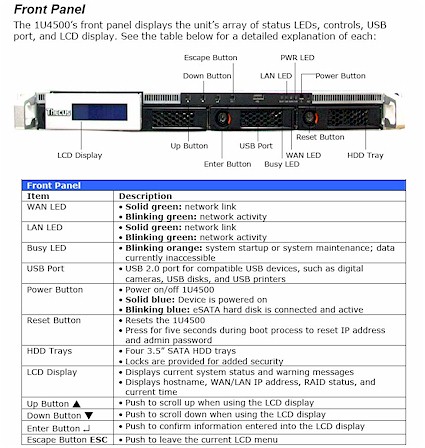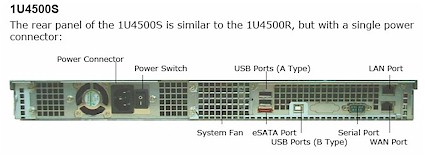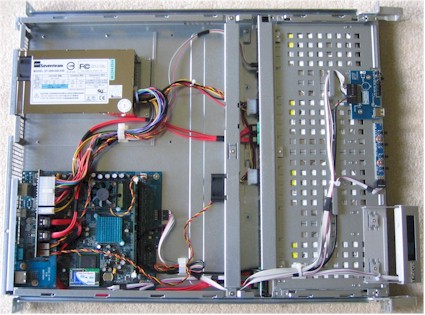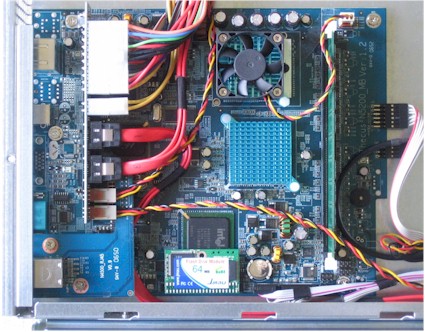Introduction

| At a Glance | |
|---|---|
| Product | Thecus Ultra-high Performance 1U Storage Server (1U4500) |
| Summary | More powerful, four bay rackmount version of N5200 BYOD NAS with RAID 0, 1, 5, 6, 10 and JBOD support. |
| Pros | • High performance • Hot-swappable drives • NFS, AFP support • eSATA port • Hot-swap redundant power supply version available |
| Cons | • Very Noisy – server room only • Documentation lacking in key areas • Web interface still needs work |
Take a Thecus N5200, drop one drive, double the processor speed and memory and put it into rackmount form and you have the 1U4500. Actually, Thecus’ entry into the realm of rackmount servers has a few more tricks up its sleeve, but the description above captures its essence.
As its name implies, the 4500 is one rackmount unit (1.75" / 44mm) high and comes with rackmount ears for bolting right into a 19" rack. It’s about 22" deep, so you might need to support it with a rack shelf, which is not provided.
Given the constraints of the 19" form factor, Thecus could include only four drives in the 4500 instead of the five in the desktop N5200. But with a little ingenuity, it managed to keep the N5200’s LCD display by encasing it in a thin aluminum case that swings up out of the way, should you need to replace the hard drive behind it.
Figure 1: 1U4500 Front panel
The buttons that go along with the display, plus other indicators are integrated into the thin strip above the drives as shown in Figure 1. You’ll also find Power and Reset buttons and a single USB 2.0 port there. Each drive is mounted on a metal tray that includes a key lock.
Thecus has improved the design of the trays over the N5200’s and I found them much more robust. I liked having the front panel power button, but didn’t like that it required only a momentary press to initiate shutdown.
The rear panel shot in Figure 2 is for the 1U4500S version which Thecus provided for review. There’s also a 1U4500R model with a second, redundant, hot-swappable 250W power supply. This is a nicer design choice than the redundant power unit required by Linksys’ NSS series, which costs around $800 and requires another 1U rackmount space.
Figure 2: DS207 Inside view
The rear panel connector complement is similar to the N5200’s, but not identical. Like the N5200, two USB 2.0 and a single eSATA port are provided for drive expansion. But you need to format any external drives first on another system using FAT32 or NTFS. FAT32 formatted drives will have read/write permission but NTFS drives will be read only.
The USB ports can also be used to attach a printer for the internal IPP print server. Also like the N5200, the 4500 can be used as an external Windows USB drive via its "Target USB" feature and USB "B" type port.
Unlike the N5200, the 4500’s serial port can be pressed into service to connect to a UPS to initiate shutdown in the event of line power failure. And where the N5200 had a 4 port switch as its "LAN" port(s), there is only a single 10/100/1000 LAN port in the 4500 in addition to the gigabit "WAN" port.
Internal Details
The internal chassis shot in Figure 3 shows a lot of empty space in the rear part of the chassis (to the left in the photo) for the single power-supply version. The drives mount in the cage to the right of the photo. As mentioned earlier, there is space for four user-supplied 3.5" drives, which can be SATA II and have capacities up to 750 GB. The 4500 uses the ext3 filesystem for the internal drives.
Figure 3: Inside the chassis
Figure 4 shows a detail view of the 1U4500’s board. The spec sheet calls out an 1.5 GHz Intel Celeron M instead of the 600 MHz Celeron M in the N5200. There is a single DIMM slot that holds 512 MB of RAM instead of the 256 MB in the N5200. And like the N5200, there is a 64MB flash microdisk at the bottom center of the shot.
Figure 4: Detail view of board
Using my trusty Kill-a-Watt power meter, I measured the 4500’s power consumption at around 86W while active and approximately 62W when the "Disk Power Management" kicked in. I think the power save just spins down the drives, since the fan noise remains constant even with the lowered power draw.
And speaking of fan noise, it’s significant. The constant drone from its two fans (one in the power supply, the other internal and behind the drive bay) banished it to my utility room instead of the test bench for the duration of its stay at the SmallNetBuilder lab.
Features
As I pointed out at the top of this review, the 1U4500 and N5200 have very similar feature sets. Visit the N5200’s review for a feature walkthrough or browse through the admin screenshot slideshow.
![]() Check out the slideshow for an admin interface tour.
Check out the slideshow for an admin interface tour.
The main feature differences I found were the inclusion of a Mediabolic UPnP AV media server (Figure 5) and support for UPS shutdown from serial-port UPSes (Figure 6). Otherwise the 4500’s features and admin interface were a virtual copy of the N5200.
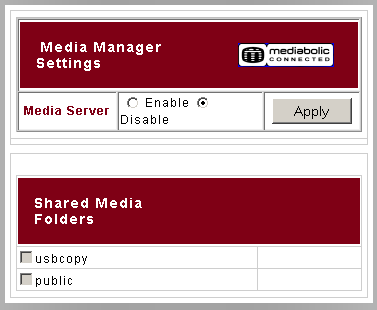
Figure 5: Media server
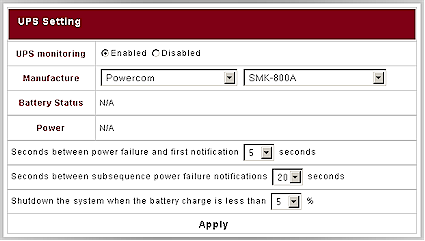
Figure 6: UPS settings
Another thing worth mentioning is that it took only four hours to build and sync a 1TB RAID 5 array. Other RAID 5 NASes I’ve tested lately took 12+ hours to do the same job. This won’t be of concern to most users, however, since the arrays are available for use, although at degraded performance, while syncing.
Performance
I tested the 4500 in JBOD and RAID 5 modes with 100 Mbps, 1000 Mbps and 1000 Mbps w/ 4k jumbo frame LAN connections using our iozone-based test procedure. The 4500 usually, but not always, significantly exceeded the N5200’s throughput. Table 1 shows a sampling of average throughput results for large filesizes with a gigabit LAN connection.
| Test | Thecus 1U4500 |
Thecus N5200 |
|---|---|---|
| RAID 5 Write | 35.5 | 34.5 |
| RAID 5 Write – 4k jumbo | 37.4 | 35.1 |
| RAID 5 Read | 36.1 | 31.8 |
| RAID 5 Read – 4k jumbo | 33.8 | 32.9 |
Table 1: Average Throughput – Large filesizes
NOTES:
- Firmware version tested was 1.00.02
- Tests were performed with four Western Digital WD3200KS drives supplied by Thecus
- The full testing setup and methodology are described on this page
- To ensure connection at the intended speeds, the iozone test machine and NAS under test were manually moved between a NETGEAR GS108 10/100/1000Mbps switch for gigabit-speed testing and a 10/100 switch for 100 Mbps testing.
I used the NAS Charts to plot the throughput vs. filesize comparison plots shown in Figures 7 and 8. Figure 7 shows both the 4500 and 5200 besting the Linksys NSS4000 for RAID 5 writes with a gigabit 4k jumbo frame LAN connection and the 4500 also beating the 5200.
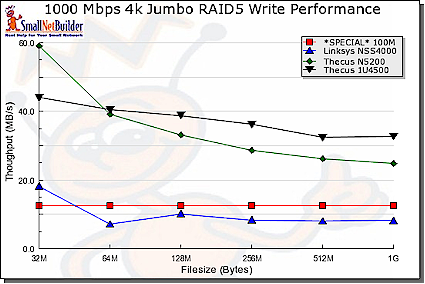
Figure 7: Gigabit 4K Jumbo Write performance comparison
Figure 8 shows a more interesting picture for RAID 5 reads. The 4500 doesn’t beat the other products until the 256 MB file size and then drops close to the 5200’s performance for 512 MB and 1 GB file sizes.
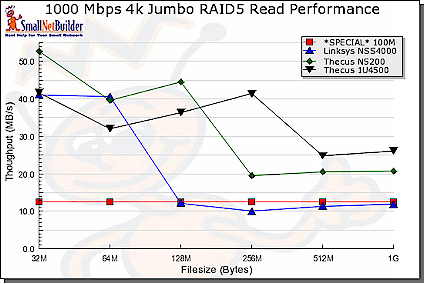
Figure 8: Gigabit 4K Jumbo Read performance comparison
The upshot is that the 4500 has a performance edge over the 5200 and most other RAID 5 NASes tested to date. But depending on your mix of file sizes, you might not see much of a difference between the two in typical use.
Closing Thoughts
Thecus continues to expand its product line, keeping its primary focus on throughput. The 1U4500 seems to provide a good value proposition over its rackmount competition with its BYOD approach and optional integrated redundant power supply.
But while it seems to have made some strides in firmware, its user interface is still unsophisticated compared to say, the Linksys NSS4000 or Infrant 1100. And some of the comments posted over in the N5200 review about Thecus service and reliability don’t exactly inspire buyer confidence.
The bottom line for the 1U4500 is basically the same as for the N5200, with slightly improved performance. It’s a hell of a fast NAS with a decent feature set. But the risk of dealing with a still relatively-unknown supplier with a small U.S. service and distribution structure may steer business buyers toward more well-known brands.
![]() Be sure to see the slideshow for an admin interface tour.
Be sure to see the slideshow for an admin interface tour.

